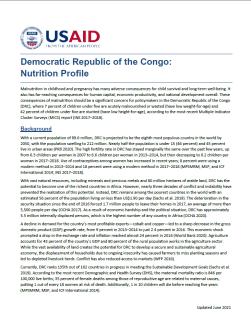With a current population of 89.6 million, DRC is projected to be the eighth most populous country in the world by 2050, with the population swelling to 212 million. Nearly half the population is under 15 (46 percent) and 45 percent live in urban areas (PRB 2020). The high fertility rate in DRC has stayed marginally the same over the past few years, up from 6.3 children per woman in 2007 to 6.6 children per woman in 2013–2014, but then decreasing to 6.2 children per woman in 2017–2018. Use of contraceptives among women has increased in recent years; 8 percent were using a modern method in 2013–2014 and 18 percent were using a modern method in 2017–2018 (MPSMRM, MSP, and ICF International 2014; INS 2017–2018).
With vast natural resources, including minerals and precious metals and 80 million hectares of arable land, DRC has the potential to become one of the richest countries in Africa. However, nearly three decades of conflict and instability have prevented the realization of this potential. Instead, DRC remains among the poorest countries in the world with an estimated 56 percent of the population living on less than US$1.90 per day (Sachs et al. 2019). The deterioration in the security situation since the end of 2016 forced 1.7 million people to leave their homes in 2017, an average of more than 5,500 people per day (OCHA 2017). As a result of economic hardship and the political situation, DRC has approximately 5.5 million internally displaced persons, which is the highest number of any country in Africa (OCHA 2020).
A decline in demand for the country’s most profitable exports—cobalt and copper—led to a sharp decrease in the gross domestic product (GDP) growth rate, from 9 percent in 2013–2014 to just 2.4 percent in 2016. This economic shock prompted a drop in the exchange rate and inflation reached almost 24 percent in 2016 (World Bank 2020). Agriculture accounts for 43 percent of the country’s GDP and 80 percent of the rural population works in the agriculture sector. While the vast availability of land creates the potential for DRC to develop a secure and sustainable agricultural economy, the displacement of households due to ongoing insecurity has caused farmers to miss planting seasons and led to depleted livestock herds. Conflict has also reduced access to markets (WFP 2016).
Currently, DRC ranks 135th out of 162 countries in progress in meeting the Sustainable Development Goals (Sachs et al. 2019). According to the most recent Demographic and Health Survey (DHS), the maternal mortality ratio is 846 per 100,000 live births; 35 percent of female deaths among those of reproductive age are related to maternal causes, putting 1 out of every 18 women at risk of death. Additionally, 1 in 10 children will die before reaching five years (MPSMRM, MSP, and ICF International 2014).

